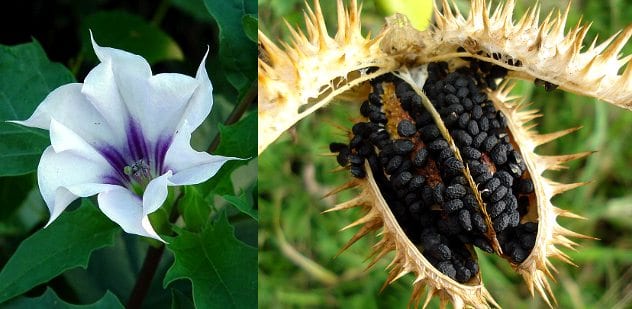10Manchineel
The manchineel (Hippomane mancinella) is a fruiting tree found in the coastal regions of the Caribbean, including the West Indies and Central America. The locals of Spanish speaking countries refer to this tree as “arbol de la muerte” or the tree of death. This ominous name does not come lightly to this simple tree. The manchineel is extremely toxic. The tree produces a sap which can ooze from the bark, leaves, fruit, and even twigs that have snapped from the tree. The sap causes burn-like blisters on the skin; if the sap makes contact with an open wound, it can enter the bloodstream and cause death. The burning of the manchineel tree can cause toxins to be released into the air; contact with the eyes can cause extreme irritation and in some cases blindness. The fruit of the machineel is of particular concern due to its small shape and appetizing appearance. Looking like a small apple, it appears to be quite edible. Eating the fruit, a consumer will be greeted with a pleasant, sweet taste. This taste is then followed by the swelling and closure of the throat and potentially death. Due to its extreme toxicity, natives in the realm of the manchineel have used the sap of the tree to coat their arrows when hunting. The machineel is proof that sometimes the sweetest things can have the sourest consequences.
9The Rosary Pea
The rosary pea (Abrus precatorious) is an Indonesian plant that is often referred to as the “crab’s eye.” Due to its beautiful red and black coloration, the rosary pea is often used in jewelry making, particularly the making of ornamental rosaries. Although native to Indonesia, the Rosary Pea was introduced to the United States as an ornamental plant, where it has become naturalized and grows rapidly in the southern United States, Hawaii, and Puerto Rico. Although the vine produces beautiful pink flowers and delicate red and black peas, the beauty of this plant hides a sinister secret. The peas of this plant are exceedingly toxic. When the skin of the Rosary Pea is broken, it takes less than 0.00015% of the toxin to kill a human. However, if the skin of the pea is unbroken, the pea is not harmful, simply passing through the digestion tract of the consumer. Abrin, the toxin of the rosary pea, attacks the cells of the human body inhibiting protein synthesis which is imperative for cell health. The rosary pea has two ways of attacking the human body: inhalation and ingestion. If inhalation of the the rosary pea toxin occurs, the victim will experience nausea, fever, and pulmonary edema. Ingestion of the toxin proves even more detrimental to humans. Ingestion of a punctured pea causes extreme nausea and vomiting which leads to dehydration, followed by the shutting down of the kidneys, liver, and spleen, resulting in a painful death. Currently, there is no antidote to the toxins of the rosary pea; medical attention is given to placate and alleviate the pain of the symptoms, but there is no way to inhibit the toxins from ravaging the body.
8White Snakeroot
The white snakeroot (Ageratina altissima) is a flowering North American herb that is found primarily in wooded areas of the Midwest. White snakeroot is a petite plant, standing three feet (91 cm) tall and topped with clusters of small white flowers. Although this plant appears diminutive and harmless in appearance, this little beauty hides a deadly secret. White snakeroot contains a potent unsaturated alcohol known as tremetol, and it is most commonly introduced to the human body secondhand via a disease known as milk sickness. Milk sickness begins its journey to the human by first entering the body of cows; the grazing cows ingest the white snakeroot unaware of the damage it will cause. The tremetol causes the cows to develop a syndrome called the trembles, aptly named because it causes the cows to tremble and shake violently. The milk from the cows is then consumed by humans, thus passing the tremetol into the system of the human causing the debilitating milk sickness. Milk sickness presents a myriad of symptoms including loss of appetite, weakness of the body, stiffness of muscles, along with gastrointestinal distress, vomiting, and constipation. After the tremetol has ravaged the body, its final act of wrath is to induce a coma, ultimately leading to death. The best hope of relief for those suffering from milk sickness is to attempt decontamination of the toxin from the body by using sodium lactate and glucose. However, more commonly, the patient is just kept as comfortable as possible until they succumb to the wrath of the white snakeroot.
7Oleander
The common oleander (Nerium oleander) is an ornamental bush prized for its beautiful flowers and robust nature. Originally from northern Africa and the Mediterranean, the oleander now flourishes in warm locales in various locations around the globe, including the dry and southernmost parts of the United States. This ornamental bush is prized by gardeners and homeowners alike; however, few realize just how deadly this flowering beauty is. The oleander contains multiple toxins that can be deadly to humans including cardiac glycosides, oleandrin, oleondroside, neroside, and a plethora of unknown toxins. This potent chemical concoction is so toxic that only one leaf is needed to kill an adult human. The toxins in the oleander are plentiful, and they cause a varied array of potentially deadly symptoms in humans: blurred vision, debilitating gastrointestinal distress, slowed or irregular heartbeats, as well as a multitude of incapacitating issues concerning the brain. Nearly all of the major organ systems of the body are directly affected. If medical attention is sought quickly after ingesting the oleander, many people can recuperate and survive the poisoning based on the amount of oleander ingested. Hospitals will pump and administer charcoal to the stomach of patients, in an attempt to purge the deadly toxins. However, many, not knowing they have been poisoned by a seemingly common plant, will die a painful death.
6Jimson Weed
Jimson weed (Datura stramonium) is known by the common name devil’s snare. Many may remember this name as Harry, Hermione, and Ron came face to face with it when searching for the sorcerer’s stone. However, the real devil’s snare is more diabolical than that found at Hogwarts. True devil’s snare is a tall, flowering plant that produces funnel-shaped flowers and prickly seed pods. Native to Asia, the toxic plant has made its way to the West Indies, Canada, and the United States. Although the devil’s snare seems plain and unassuming, this plant is packed with a powerful punch. The devil’s snare contains a mixture of tropane alkaloids which can affect nearly every aspect of the human body but are particularly debilitating to the brain. Commonly used as a psychedelic drug, devil’s snare can cause dilated pupils, blurred vision, frightening hallucinations, confusion, euphoria, delirium, combative behaviors, as well as tachycardia, and dry mouth. Devil’s snare typically enters the body directly; a person will suck the juices from the plant stem or flowers, or simply ingest one of the seeds from the prickly pod. And while death is not always certain, devil’s snare will take you on a trip that is not going to be pleasurable.
5Castor Beans
Castor beans come from the castor bean plant (Ricinus communis), and though the beans themselves may look harmless, they contain one of the most potent natural toxins on earth, ricin. The castor plant is a medium height, herb-like plant originating from Ethiopia. The plant has become quite common worldwide in temperate and tropical climates; the southwest United States has seen an increase in castor plant population. Many grandmothers have sworn the benefits of castor oil which comes from the castor plant, so why is it so deadly? Well, the secret is the mottled, brown castor beans. The beans are the vessels that contain the ricin. The ricin is contained in the pulp of the bean after it has been either broken or chewed. The pulp can be used to create a dried powder that can be either inhaled or mixed with liquids to create an injectable poison. Scary, right? Well depending on how the ricin ends up in the human body, each method of poisoning creates a different set of life-threatening symptoms. If ingested, ricin causes extreme gastrointestinal inflammation, abdominal pain, vomiting, and bloody diarrhea which results in extreme dehydration, decreased blood pressure, and decreased urine production. Inhalation of ricin results in a bloody cough quickly followed by pulmonary edema. If ricin is injected, vomiting, flu-like symptoms, and swelling at the injection site occurs, followed swiftly by organ failure. Scarily, these symptoms only show up several days after being exposed to ricin. It takes less than two milligrams to kill an adult human, and there is no cure. You will think twice the next time grandma offers you the castor oil for what ails you.
4 Deadly Nightshade
Deadly nightshade (Atropa belladonna) is known worldwide as belladonna, often translated simply as “beautiful lady.” This lady, although she is beautiful, is exceedingly dangerous. Native to Europe, North Africa and western Asia, belladonna has become commonplace in the United States. Belladonna is a tall plant with dark green leaves, beautiful purple, bell-shaped flowers, and black-red berries. Overall, belladonna lives up to her name as a beautiful lady. However, contained within the plant are toxins that kill with ease. The belladonna contains three tropane alkaloids and other toxic components which cause a plethora of symptoms upon poisoning a human: extreme thirst, difficulting swallowing and breathing, blurred vision, vomiting, rapid heartbeat, slurred speech, hallucinations, and delirium; convulsions and coma soon follow, ultimately leading to death. Belladonna contains toxins throughout the entire body of the plant, with the roots being the most potent. However, it is the berries that cause the most trouble. The shiny, dark, black-red berries resemble ripe cherries. People pluck the berries, unaware of their toxicity, and discover upon tasting that they are quite sweet. However, the after effects of this kiss of sweetness are anything but pleasant. This is a forbidden fruit that needs to stay forbidden.
3The Suicide Tree
The suicide tree (Cerbera odollam) is a beautiful ornamental plant native to the swamps of India and southern Asia. Although known by the natives as “pong-pong,” this tree has a devious tactic to lure you in and fool you into an early death. The suicide tree has beautiful white flowers and also produces a small fruit which resembles a little mango. Sounds appetizing, yes? What unsuspecting munchers do not realize is that the little green fruit’s seed is highly toxic. The seed of the suicide tree contains glycoside cerberin. The cerberin acts as a steroid that blocks the calcium ion channels in humans. The symptoms of cerberin ingestion include severe stomach distress, diarrhea, irregular heart rhythms, cardiac distress, and vomiting. These symptoms occur within hours of ingesting the seed, and just one contains enough poison to kill an adult human. The suicide tree comes by its name honestly; the seed within the fruit of the suicide tree is used by thousands of people yearly as a quick and not so pleasant method of suicide.
2Water Hemlock
Water hemlock (Cicuta douglasii) is a weed native to the wetlands of the American West. This seemingly ordinary plant stands a meter tall and has clusters of tiny white flowers at the tip of its many branches. When broken, the water hemlock produces a thick sap that flows freely from the interior of the plant. A member of the carrot family, this is one plant that you do not want to add to a lunchtime salad. The water hemlock is saturated with a toxin known as cicutoxin—a form of unsaturated alcohol that smells remarkably like a carrot. Cicutoxin can be found throughout the entire plant body. Most often, the water hemlock is directly ingested by a person, usually after misidentification of the toxic plant. After ingestion of the water hemlock, a wide variety of symptoms begin to take their toll on the body. These include nervousness, muscle twitching, dilation of pupils, rapid pulse and breathing, tremors, convulsion, grand mal seizures, coma, and then a very quick death. A mere mouthful of the water hemlock has enough poison to kill an adult human. Poisoning by the water hemlock happens so quickly; this carrot family villain will give you no time to reach a hospital and have the chance to ask “what’s up, Doc?”
1Monkshood
Monkshood (Aconitum napellus) is a flowering plant that has many aliases including tiger’s bane, dog’s bane, soldier’s helmet, and old wife’s hood. Native to western and central Europe, monkshood is a perineal, ornamental flowering plant most easily recognized by its deep violet flowers, which are shaped much like the hood of a monk. Although named after priestly garb, this plant it no saint; in fact, this violet beauty is the ultimate sinner. Monkshood contains an alkaloid known as aconitine. Aconitine causes damage to the sodium channels that are directly related to heart functionality. Symptoms of monkshood poisoning include tingling, numbness of the mouth and tongue, nausea, vomiting, labored breathing, weak and irregular heartbeat, pain, convulsions, and paralysis ultimately leading to death. Poisoning due to monkshood is mostly by ingestion; however, the taste of the plant is quite unpleasant. Just one bite is all it takes to bring on a wave of pain and death. Library Tech. Grad student. Full time geek.
























